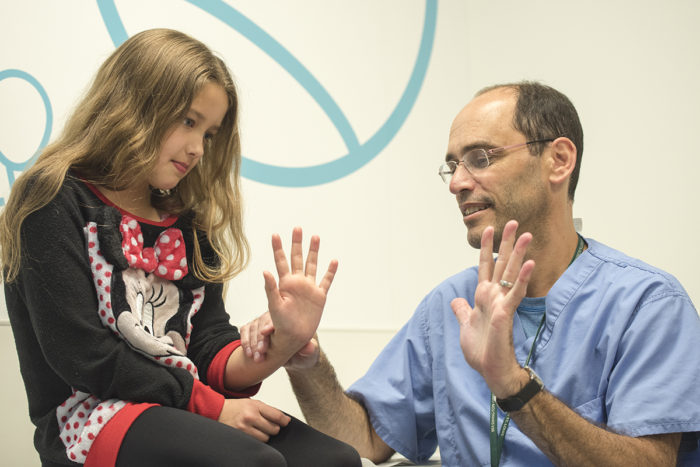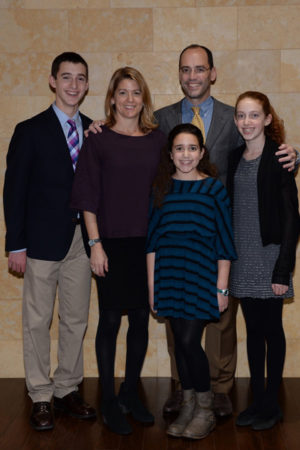Washington People: Charles Goldfarb
Hand specialist treats kids with birth differences, athletes with hand injuries, other ailments
 Robert Boston
Robert BostonCharles A. Goldfarb, MD, examines patient Chloe Mullins during a recent appointment at the St. Louis Children's Specialty Care Center in west St. Louis County.
Growing up in Birmingham, Ala., Charles A. Goldfarb was the youngest son of a head and neck surgeon. Although his older brother and sister became lawyers, Goldfarb initially thought he might follow his father’s path, but when he was exposed to orthopedics, he knew he’d found his calling.
“What had attracted me to head and neck surgery was the intricacy of the anatomy,” said Goldfarb, director of the Division of Pediatric and Adolescent Orthopaedic Surgery at Washington University School of Medicine in St. Louis. “But the area around the hand also is very intricate, and from my perspective, those are the two most interesting anatomical areas of the body.”
Another attraction was the link between orthopedics and sports. Goldfarb was a history major and a varsity college soccer player at Williams College in Massachusetts, proudly representing the school that gave the world Stephen Sondheim, John Sayles and perhaps the best mascot name in all of athletics: Ephelia the Purple Cow.
Sports have remained part of his professional life. When athletes need hand surgery, his phone rings.
“I like to say my practice has three parts, and it’s an unusual combination,” explained Goldfarb, who treats patients through Washington University Orthopedics and St. Louis Children’s Hospital. “One part involves taking care of kids, particularly kids with birth differences, which is where my love and my research lie. The next part is sports — athletes at all levels. It started because the Rams needed a hand surgeon, and I have since been fortunate enough to take care of players from the Blues and the Cardinals and other places, too.”
The third part of his practice involves treating more common hand problems, including carpal tunnel syndrome, broken fingers and lacerations.
“Dr. Goldfarb is a superb surgeon with an extraordinary range of talents,” said Regis J. O’Keefe, MD, PhD, the Fred C. Reynolds Professor and head of the Department of Orthopaedic Surgery. “Children with the most complex hand deformities and elite athletes from all over the country come to St. Louis for his care. His commitment and personal qualities make him a role model for our residents and a trusted colleague and leader in our department.”
Right place, right time
Goldfarb came to the Washington University Medical Campus as a resident. After Williams College — where he met his wife — he returned to Birmingham for medical school at the University of Alabama at Birmingham.
“That’s where I fell in love with orthopedic surgery,” he said. “My wife, Talia, came down to Alabama. She was two years behind me at Williams, and we married when she graduated. Then my residency brought me here.”
That was 1995, just as Richard H. Gelberman, MD, had arrived, become the inaugural head of the Department of Orthopaedic Surgery and started to assemble a faculty of experts in several orthopedic specialties.
“I interviewed with him that year,” Goldfarb recalled. “Our class was his first residency-selected class, and we arrived knowing how great Washington University was but also hoping that great things would happen in the department, which, obviously, has absolutely happened. We arrived at the right time.”
Goldfarb said he had an inkling that he eventually wanted to go into hand surgery, so the presence of Gelberman, a renowned hand specialist, and the late Paul R. Manske, MD, helped attract him to St. Louis. Manske, also a hand specialist, had directed the university’s Division of Orthopaedic Surgery before it became a department.
“His practice focused on kids with birth differences,” Goldfarb said. “When I did my residency, I really liked almost every one of my rotations, but I had a special affinity for working with kids. And I’ve really been able to marry the hand work and the kids part. For a long time, my practice was mainly hand surgery, and I did some work with kids. Now it really leans strongly toward pediatric orthopedics and congenital hand surgery, though I still do treat some adults.”
Goldfarb — chief of orthopedic surgery and co-chief of the hand and wrist service at St. Louis Children’s — also treats patients at Shriners Hospitals for Children-St. Louis. It was at Shriners that he and Manske treated the child who still ranks as his most unusual case.
“He was from Central America, and he was born with three arms,” Goldfarb recalled. “We were able to surgically combine two minimally functional arms and make them into a pretty good functional arm. It was an operation that never had been done before for a condition that never had been reported before. That young man still comes back and forth from Central America for follow-up appointments, and it’s been really neat to watch him grow.”
Using 3-D printers
With that child from Central America, Goldfarb was able to help build a functioning, biological arm. But that’s not always possible. Birth differences and traumatic injuries mean a number of his patients need prostheses instead.
“Prostheses are heavy, and they’re expensive,” he said. “It used to be that we would force kids, at six months of age, to wear them, and the reality was that we could require that for a few minutes, but they would abandon them pretty quickly.”
Then, a few years ago, a team of undergraduates at Washington University began working on a senior project in biomedical engineering, and they contacted Goldfarb about building a prosthesis with a 3-D printer. They worked together to make a lightweight, powered prosthesis with fingers that move. Such devices also can be printed in bright colors, giving kids who wear them somewhat of a superhero appearance.
“The concept that a prosthesis should look as natural as possible has been flipped on its head,” he said. “Instead of trying to hide the birth difference a kid may have, these new 3-D-printed prostheses almost say ‘Look at me!’ Although it’s not quite ready for prime time, using these 3-D printers to make prostheses is advancing at a rapid speed.”
Saturday morning soccer
Although he doesn’t protect a goal anymore, Goldfarb and his children — Jake (17), Kylie (14) and Macy (12) — regularly tune in for English soccer games on weekend mornings. He also plays pick-up basketball early on Saturdays.
His social life mainly centers on family activities.
 courtesy of C. Goldfarb
courtesy of C. Goldfarb“I wouldn’t say I have the best work-life balance, but that’s the goal, and my free time with the family tends to involve our kids’ activities, such as sports or dance or plays,” Goldfarb said.
Whether his kids will follow their father and grandfather into medicine isn’t yet clear, and Goldfarb isn’t pushing.
“They have a lot of interests, and all of them are pretty good at the things they like to do,” he said. “If any of them decide to pursue medicine, I’d be happy as long as they’re happy, just as my father was happy one of his kids decided to go into medicine.”







